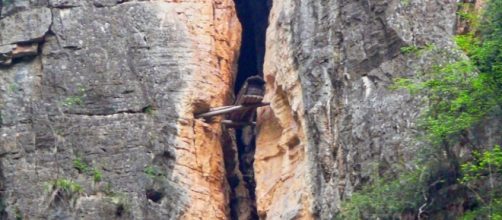All cultures have burial customs specific to their religious beliefs or where they live. The Hanging Coffins of Southern China were specific to the Bo People approximately 3,000 years ago. Historic Mysteries cites that the practice probably began in the Fujian province and eventually spread to the Hubei, Sichuan, and Yunnan provinces. Today the practice of hanging the dead is only used by the Igorot Tribe in the Philippine Mountain Province. An Igorot tribal member acknowledged that their practice began over two millennia ago and was driven by the fact that underground burials result in quick decay from water seeping into the ground.
Bo coffins were often made from the hollowed out trunks of the Nanmu tree because of the density and resistance of its wood to decay. Coffins were not only hung on wooden stakes driven into the cliffs but in natural and man-made caves or on natural rock abutments. Since the Bo People disappeared somewhere near the end of the Ming Dynasty most of what is known about the Bo and their Hanging Coffins is based on anthropological and historical conjecture and discoveries being made as the coffins are being repaired and restored in their original locations.
The reasoning behind the Bo funeral practice died along with the people
When the Bo People disappeared into the mists of time everything related to the Hanging Coffins disappeared along with them.
Anthropologists suspect that hanging the coffins far above ground had something to do with protecting the body from carnivorous animals or to shorten the dead's journey to heaven. The tradition may have incorporated both the Asian culture's deference to the family along with the ancient Chinese belief that spirits dwelled within all the various elements in nature. Guo Jing (who works for the Yunnan Provincial Museum) may have encapsulated it best when he said that "the cliffs served as the stairway to heaven, and the coffins as the bridge to the afterlife." Hanging the coffins may also have been a way to ensure a spirit's passage into the afterlife by protecting the body the spirit was housed in while alive.
The cliff tombs were airy, dry, and shaded, which would have slowed decomposition.
The enduring mystery of the Hanging Coffins, how the Bo raised them up the sheer cliffs, and why
In 2015, archaeologists scouring the cliffs along the Yangtze River discovered 131 hanging coffins located in caves beginning at 330 ft above ground. With no written records to go by and no other definitive proof, most experts have reached the conclusion that the bodies were probably raised using pulleys and scaffolding. Archaeologists declared that the weight of both the corpse and the coffin together could have reached several hundred pounds depending on the age and sex of the deceased. Trying to figure out how the Bo raised the bodies of their dead to such difficult places and heights has been a controversial subject of discussion among scientists, historians, and various scholars for years -- and one that may forever remain a mystery.


